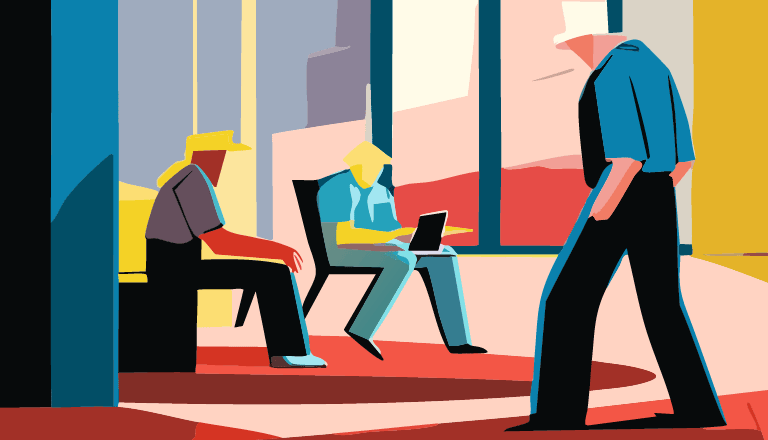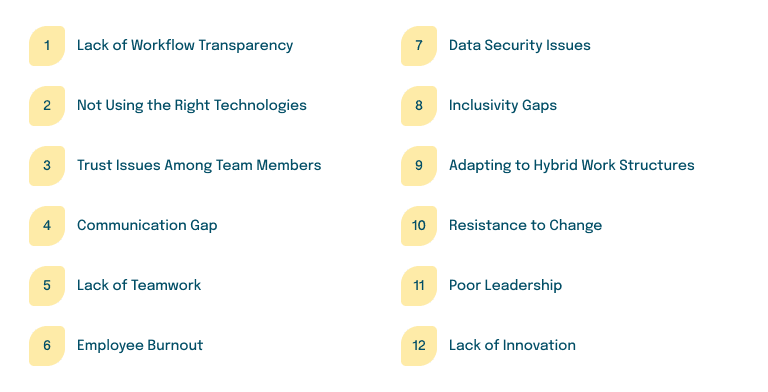project management · Dec 30, 2024
12 Workplace Challenges and Solutions to Avoid in 2025

Introduction
As 2025 approaches, the workplace continues to evolve rapidly, bringing new opportunities and fresh challenges. With remote work trends, technology integration, and diverse team dynamics shaping the landscape, understanding common pitfalls and having actionable solutions is critical for any successful organization.
This post covers twelve of the most pressing workplace challenges expected in 2025, each accompanied by practical solutions and insights into how tools like Quire can help navigate them efficiently.

1. Lack of Workflow Transparency
One of the most significant obstacles to achieving efficiency and collaboration in the workplace is the lack of workflow transparency. When employees are unclear about responsibilities, priorities, or deadlines, it creates confusion and hinders progress.
Miscommunication and hidden bottlenecks can lead to delayed projects, increased stress, and dissatisfaction among team members. Moreover, without a transparent system, managers struggle to track progress, making it difficult to identify and address potential issues proactively. This challenge often escalates in teams working on complex projects or across multiple locations.
Solutions to This Challenge
- Implement visual task management tools like Quire to map project stages and responsibilities. A Kanban or Gantt chart view ensures everyone knows the current progress.
- Promote regular updates and documentation within the team so that everyone is aware of changes or progress. Stand-up meetings or asynchronous updates can aid transparency.
- Encourage open feedback loops where team members can ask questions and provide updates on task status. This strengthens collective responsibility and accountability.
2. Not Using the Right Technologies
Technology plays a pivotal role in determining an organization’s productivity and efficiency. Yet, many workplaces rely on outdated tools or fail to invest in software that meets their specific needs. Using the wrong technologies can lead to inefficiencies, frustration, and a lack of engagement among employees.
For instance, juggling multiple disconnected tools often results in missed updates, redundant work, and wasted time. Furthermore, without the right technology, teams may struggle to adapt to industry changes and miss opportunities for growth.
Solutions to This Challenge
- Evaluate and update your tech stack annually to ensure it aligns with your business objectives and industry standards. New software solutions like Quire offer agile updates to stay relevant.
- Invest in comprehensive training programs to ensure that everyone knows how to use the chosen technology effectively. Regular workshops and tutorials are key.
- Integrate tools that support seamless collaboration across different team functions. Choosing software that integrates with calendars, messaging apps, and document-sharing platforms enhances productivity.
3. Trust Issues Among Team Members
Trust is the cornerstone of a high-performing team, yet it can be fragile. Teams lacking trust often experience conflicts, reduced collaboration, and low morale. This issue can arise from past misunderstandings, unequal task distribution, or limited opportunities for team members to build personal connections.
Trust issues are particularly prevalent in remote or hybrid work environments, where opportunities for face-to-face interaction are limited. The absence of trust not only impacts team dynamics but can also stall innovation and productivity.
Solutions to This Challenge
- Promote team-building activities that allow members to bond in both formal and informal settings. Virtual and in-person sessions can bridge gaps.
- Foster a culture of recognition and appreciation where team members celebrate each other's efforts and accomplishments. Recognition drives motivation and trust.
- Use transparent task assignments in tools like Quire to show who is accountable for each task, encouraging responsibility and peer trust.
4. Communication Gap
Effective communication is the backbone of any successful organization. However, many workplaces struggle with communication gaps due to unclear channels, cultural differences, or inadequate tools. Miscommunication often leads to mistakes, missed deadlines, and interpersonal conflicts.
For global or distributed teams, time zone differences and language barriers can exacerbate this problem. Organizations that fail to address communication gaps risk decreased productivity and employee dissatisfaction, creating a ripple effect on overall business performance.
Solutions to This Challenge
- Adopt a unified communication platform that centralizes all messages, discussions, and updates. Quire's integration with various tools can streamline communication channels.
- Encourage regular team meetings (both virtual and in-person) to clarify expectations and update everyone on the current status of projects.
- Promote a culture of active listening, ensuring that team members understand each other's perspectives and needs. Providing training on communication best practices can be beneficial.
5. Lack of Teamwork
Teamwork is essential for achieving shared goals and fostering innovation. However, many organizations face challenges in building cohesive teams. Factors such as poorly defined roles, internal competition, and a lack of shared objectives can hinder collaboration.
The absence of teamwork not only affects productivity but also damages employee morale and engagement. As work becomes increasingly cross-functional, organizations must prioritize teamwork to stay competitive and deliver results.
Solutions to This Challenge
- Define roles and responsibilities clearly so that each team member knows their part and how it contributes to the greater mission. Tools like Quire help visualize contributions through task assignments.
- Encourage a collaborative work culture by emphasizing cross-functional projects and shared milestones. Use online collaboration tools to foster teamwork.
- Refer to extended reading on building collaboration and teamwork, such as Quire’s article on '5 Ways to Improve Team Collaboration' for more insights.
6. Employee Burnout
Burnout has become a critical issue in modern workplaces, driven by high workloads, tight deadlines, and constant connectivity. Employees experiencing burnout are more likely to disengage, make errors, and eventually leave their positions.
This issue not only impacts individual well-being but also affects overall team productivity and company performance. Identifying burnout early and taking preventive measures is vital for maintaining a healthy and motivated workforce.
Solutions to This Challenge
- Encourage work-life balance by setting realistic deadlines and promoting flexible work arrangements.
- Monitor workloads to ensure no team member is consistently overwhelmed. Use Quire’s workload view to balance tasks effectively.
- Provide access to mental health resources and create an open environment where employees feel comfortable discussing stress or burnout.
7. Data Security Issues
In an era of digital transformation, data security has become a top priority for organizations. Cyberattacks, data breaches, and human errors pose significant threats to sensitive information.
Failure to address these risks can result in financial losses, reputational damage, and legal penalties. With remote work becoming the norm, ensuring robust data security measures is more challenging and critical than ever.
Solutions to This Challenge
- Implement robust cybersecurity measures like two-factor authentication and regular software updates.
- Educate employees on security best practices, such as recognizing phishing attempts and using secure passwords.
- Choose tools like Quire that prioritize data encryption and compliance with global security standards.
8. Inclusivity Gaps
Diversity and inclusion are key drivers of innovation and employee satisfaction. Yet, many organizations struggle to create an environment where everyone feels valued and respected. Inclusivity gaps often stem from unconscious biases, lack of representation, and inadequate policies.
Addressing these gaps is essential for building a cohesive and dynamic workforce that leverages diverse perspectives and experiences.
Solutions to This Challenge
- Develop comprehensive diversity and inclusion training programs to address unconscious bias and promote equity.
- Create platforms for open dialogue, where employees can share their experiences and suggestions.
- Use task management tools like Quire to ensure equal opportunities in task assignments and leadership roles.
9. Adapting to Hybrid Work Structures
Hybrid work models have become increasingly popular, offering flexibility and cost savings for organizations. However, they also introduce challenges in maintaining team cohesion, ensuring equal participation, and managing productivity.
Balancing in-office and remote work arrangements requires clear policies and effective tools to support collaboration and communication. Organizations that fail to adapt risk losing talent and falling behind competitors who embrace this new way of working.
Solutions to This Challenge
- Establish clear guidelines for hybrid work, including expectations for in-office and remote workdays.
- Leverage tools like Quire to centralize project management and ensure transparency, regardless of location.
- Foster a sense of inclusion by hosting virtual team-building activities and ensuring remote employees have access to the same resources as in-office staff.
10. Resistance to Change
Change is inevitable in any organization, but it is often met with resistance from employees. Whether it involves adopting new technologies, restructuring teams, or introducing new policies, resistance can slow down progress and create friction within the workplace.
This challenge is particularly prevalent in organizations with rigid hierarchies or those that lack clear communication about the benefits of change.
Solutions to This Challenge
- Communicate the benefits of changes clearly and involve employees in the decision-making process.
- Provide thorough training and support when implementing new tools or workflows.
- Use Quire’s user-friendly interface to simplify transitions and reduce resistance.
11. Poor Leadership
Leadership plays a pivotal role in shaping workplace culture and driving organizational success. However, poor leadership—characterized by a lack of vision, ineffective communication, or micromanagement—can lead to disengaged employees and high turnover rates.
Addressing leadership challenges is critical for creating a positive work environment and achieving strategic goals.
Solutions to This Challenge
- Invest in leadership development programs to equip managers with the skills they need to lead effectively.
- Encourage transparent and empathetic communication from leaders to build trust and engagement.
- Leverage analytics tools within platforms like Quire to track team performance and identify areas for improvement.
12. Lack of Innovation
Innovation is the lifeblood of any competitive organization. Without a culture that encourages creativity and risk-taking, companies risk becoming stagnant and irrelevant. Factors such as rigid hierarchies, fear of failure, and lack of resources often stifle innovation.
Cultivating an innovative mindset requires intentional efforts to empower employees and provide them with the tools and opportunities to think outside the box.
Solutions to This Challenge
- Encourage brainstorming sessions and allocate time for creative thinking within the team schedule.
- Recognize and reward innovative ideas, creating a culture that values forward-thinking.
- Use collaboration tools like Quire to facilitate idea-sharing and track innovation-focused projects.
Conclusion
Facing workplace challenges with well-planned solutions and the right technology ensures sustained growth and enhanced collaboration. With tools like Quire, fostering workflow transparency, improving communication, and building trust becomes more achievable. Invest in the right strategies today to avoid potential pitfalls and foster a thriving, future-ready workplace in 2025.

